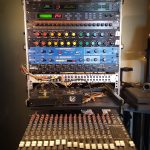 The whole point of the dub station rig, which lives in the upstairs studio, is doing live improvised electronics, mixing, and treatments. “Dub,” of course, refers to the early form of electronic music that developed out of reggae, the protagonists of which considered the mixing console as an instrument and that involved generous amounts of dynamic delay, reverb and other effects in a live mix.
The whole point of the dub station rig, which lives in the upstairs studio, is doing live improvised electronics, mixing, and treatments. “Dub,” of course, refers to the early form of electronic music that developed out of reggae, the protagonists of which considered the mixing console as an instrument and that involved generous amounts of dynamic delay, reverb and other effects in a live mix.
The first iteration of this dub rig was constructed in Boston, and was not surprisingly built primarily around the use of digital delays and feedback. This was with our buddy Jim (who developed his dub chops at the Western Front in Cambridge, MA and who we recently tracked down back in Boston, incidentally). Now the dub rig lives again in Amy’s capable hands and has been expanded to include some new effects and more filtering options. And more analog synths!
So, what do we have in this toolbox? Let’s see …
In the center is the Mackie CR-1604. This, if I’m not mistaken, was the first product Mackie ever made, back when the company was called MACKIE DESIGNS in Woodinville, Washington. It was built to last and still works great. Pretty versatile, six aux sends are nice on a compact mixer …
It wouldn’t be dub without DDLs: back in the day Jim picked out the Deltalabs Effectron and Echotron, and they’re still going strong (and still blue!). We also are using the original Yamaha SPX-90 unit for some classic ’80s reverb sound.
There’s also some new stuff. The two vintage Audiolabs parametric EQs we found on a road trip to San Francisco early this year and they sound as cool as they look. It’s nice to have some additional EQ options as the Mackie is kinda limited in that area.
We added the patch bay and shelf so we can easily drop in stompboxes, as necessary. The Big Muff and RAT you see in the photo are go-to pieces when we need real distortion.
Some other items, like the Bavarian vocoder and filter bank came back from the old Boston studio when we did the cross-country road trip with the mixing desk …
We might say something about the sound sources: We’re running Ableton (with multiple controllers, including an old Livid Ohm, that was covered in studded leather by our friends at Rough Trade in Silver Lake) that drives 8 channels of discrete audio into the analog mix. There’s also an Arturia Drumbrute (Amy’s machine of choice, these days, after she played with one at Switched On in Austin). Hardware synth sources at the moment include a Korg MS-10 and a modded Roland SH-101.